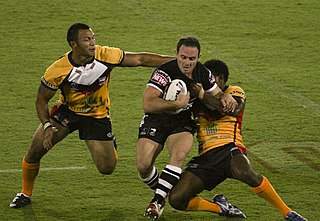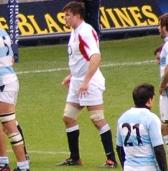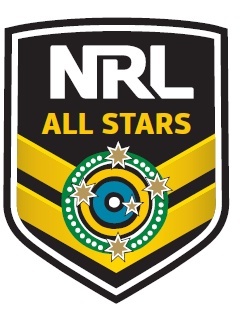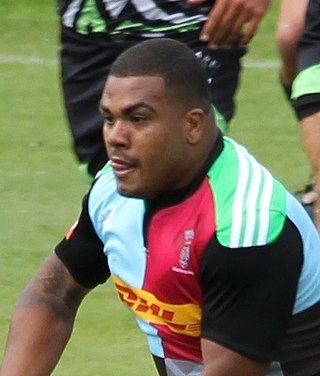
Canadian football, or simply football, is a sport in Canada in which two teams of 12 players each compete on a field 110 yards (101 m) long and 65 yards (59 m) wide, attempting to advance a pointed oval-shaped ball into the opposing team's end zone.

Rugby football is the collective name for the team sports of rugby union and rugby league.

Rugby union football, commonly known simply as rugby union or more often just rugby, is a close-contact team sport that originated at Rugby School in England in the first half of the 19th century. Rugby is simply based on running with the ball in hand. In its most common form, a game is played between two teams of 15 players each, using an oval-shaped ball on a rectangular field called a pitch. The field has H-shaped goalposts at both ends.

Rugby league football, commonly known as rugby league in English-speaking countries and rugby XIII in non-Anglophone Europe and South America, and referred to colloquially as rugby, football, footy or league in its heartlands, is a full-contact sport played by two teams of thirteen players on a rectangular field measuring 68 m (74 yd) wide and 112–122 m (122–133 yd) long with H-shaped posts at both ends. It is one of the two major codes of rugby football, the other being rugby union. It originated in 1895 in Huddersfield, Yorkshire, England, as the result of a split from the Rugby Football Union (RFU) over the issue of payments to players. The rules of the game governed by the new Northern Rugby Football Union progressively changed from those of the RFU with the specific aim of producing a faster and more entertaining game to appeal to spectators, on whose income the new organisation and its members depended.

A touchdown is a scoring play in gridiron football. Whether running, passing, returning a kickoff or punt, or recovering a turnover, a team scores a touchdown by advancing the ball into the opponent's end zone. More specifically a touchdown is when any part of the football, in the possession of an offensive player, crosses the goal line while the player, as well as the ball, is inbounds, and the player is upright. In order for a player to be down, any part of their body other than their hands or feet must touch the ground. If a player falls down without being contacted by a defensive player, whether or not they are down varies by league.

Rugby sevens is a variant of rugby union in which teams are made up of seven players playing seven-minute halves, instead of the usual 15 players playing 40-minute halves. Rugby sevens is administered by World Rugby, the body responsible for rugby union worldwide. The game is popular at all levels, with amateur and club tournaments generally held in the summer months. Sevens is one of the most well distributed forms of rugby, and is popular in parts of Africa, Asia, Europe, and the Americas, and especially in the South Pacific.

Martin Edward Corry MBE is a retired English rugby union player who represented and captained England and Leicester Tigers in a career spanning 14 seasons. Corry played 64 times for England between 1997 and 2007, played 7 tests for the British & Irish Lions on tours in 2001 & 2005, and played 290 times for Leicester between 1997 and 2009. Earlier in his career he played top division rugby for Newcastle Gosforth and Bristol. A versatile player his principal positions were number eight and blindside flanker, he also played lock more as his career progressed.

In the game of rugby union, there are 15 players on each team, comprising eight forwards and seven backs. In addition, there may be up to eight replacement players "on the bench", numbered 16–23. Players are not restricted to a single position, although they generally specialise in just one or two that suit their skills and body types. Players that play multiple positions are called "utility players".

Tag rugby, or flag rugby, is a non-contact team game in which each player wears a belt that has two velcro tags attached to it, or shorts with velcro patches. The mode of play is based on rugby league with many similarities to touch football, although tag rugby is often deemed a closer simulation of full contact rugby league than touch. Attacking players attempt to dodge, evade and pass a rugby ball while defenders attempt to prevent them scoring by "tagging" – pulling a velcro attached tag from the ball carrier, rather than a full contact tackle. Tag rugby is used in development and training by both rugby league and rugby union communities.

Central Coast Stadium is a sports venue in Gosford, on the Central Coast of New South Wales, Australia. The stadium is home to the Central Coast Mariners Association football club which competes in the A-League. The stadium also hosts rugby league and rugby union fixtures on an ad hoc basis as well as other major social events.

Nathan Sharpe is a retired professional Australian rugby union player. He began his rugby career at the Queensland Reds in 1999 before joining the newly created Western Force in 2006, where he captained the club until his retirement in 2012. He played 116 test matches for Australia, including 20 as captain. His usual position was lock.

The team sports rugby union and rugby league have shared origins and thus many similarities. Initially, following the 1895 split in rugby football, rugby union and rugby league differed in administration only. Soon, however, the rules of rugby league were modified, resulting in two distinctly different forms of rugby.
Rugby league football has accrued considerable jargon to describe aspects of the game. Many terms originate in the Laws of the Game. Some aspects of the game have more than one term referring to them. Different terms have become popularly used to describe an aspect of the game in different places, with notable differences between the Northern and Southern Hemispheres.

American football, also known as gridiron football, is a team sport played by two teams of eleven players on a rectangular field with goalposts at each end. The offense, the team with possession of the oval-shaped football, attempts to advance down the field by running with the ball or passing it, while the defense, the team without possession of the ball, aims to stop the offense's advance and to take control of the ball for themselves. The offense must advance at least ten yards in four downs or plays; if they fail, they turn over the football to the defense, but if they succeed, they are given a new set of four downs to continue the drive. Points are scored primarily by advancing the ball into the opposing team's end zone for a touchdown or kicking the ball through the opponent's goalposts for a field goal. The team with the most points at the end of a game wins.

The Rugby League All Stars Match of the National Rugby League is an annual rugby league football match between the specially-formed Indigenous All Stars and an All Stars team, both of whose members are made available for selection public vote. The game has been played since 2010 at a variety of venues across Australia. The player judged man-of-the-match is awarded the Preston Campbell Medal, named after indigenous Gold Coast player, Preston Campbell. Between 2010 and 2015, the Indigenous All Stars opponent was an NRL All Stars team, they were replaced for 2016 by a World All Stars team.
Illawarra Sports High School is a government-funded co-educational comprehensive and specialist secondary day school, with speciality in sports, located in Berkeley, a southern suburb of Wollongong, in the Illawarra region of New South Wales, Australia.

Stuart William Hogg is a Scottish former professional rugby union player. He has represented Scotland at international level, having made his test debut against Wales during the 2012 Six Nations Championship. He is Scotland's all time leading try-scorer.

Koinonia Halafungani Laumape is a New Zealand rugby union footballer who currently plays as a centre for Kobelco Kobe Steelers. Laumape previously played in Super Rugby for the Hurricanes and was previously a rugby league player for the New Zealand Warriors in the National Rugby League.

Kyle Norval Jonathan Sean Sinckler is an English professional rugby union player who plays as a prop for Premiership Rugby club Bristol Bears and the England national team.
Christopher James Harris is a rugby union player who plays centre for Gloucester in Premiership Rugby and for Scotland.
















